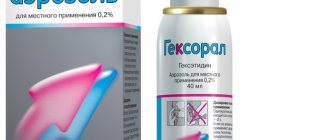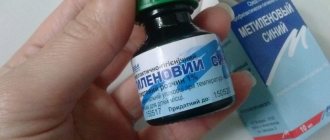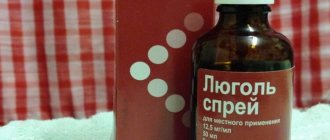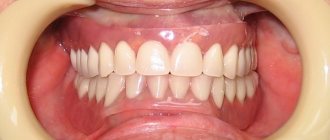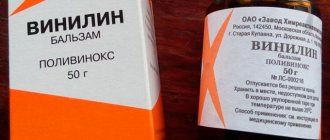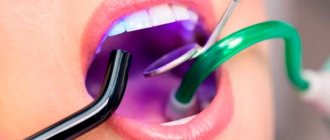Stomatitis usually refers to wounds and ulcers that occur in the oral cavity. Since children have imperfect immunity, often lick their hands and dirty objects, and cannot maintain sufficiently thorough hygiene, such a disease occurs in them quite often.
Severe pain seriously affects the quality of life and threatens complications.
There are a huge variety of drugs for the treatment of pathology, but most often doctors prescribe Chlorophyllipt for stomatitis in children.
Rinsing with medicinal solutions
An effective method of rinsing is the use of medications prescribed by the dentist.
Chlorhexidine
A 0.05% aqueous solution of chlorhexidine is used to rinse the mouth.
Directions for use: take 1 tablespoon of the product into your mouth, rinse for 1 minute 2 times a day (preferably morning and evening), about one hour before brushing your teeth.
Treatment time is no more than 10 - 12 days. The medicine is not diluted. You need to rinse continuously for a minute.
An excellent remedy that has high antimicrobial activity and copes well with painful sensations.
Miramistin
In dentistry, a 0.01% solution of miramistin is used for external use. The drug in this concentration is irrigated into the oral cavity 3-4 times a day. In this case, you should refrain from drinking and eating for 2 hours.
Important! The course of therapy is no more than seven days, continuation is only as prescribed by a doctor. Miramistin is an effective antiseptic that reduces the number of microorganisms and completely relieves inflammation, and therefore will help with pain
Miramistin is an effective antiseptic that reduces the number of microorganisms and completely relieves inflammation, and therefore will help with pain.
When can you rinse with Novocaine?
For pain relief, a medicinal solution is used with a percentage of anesthetic from 0.25% to 2% in ampoules or bottles.
To prepare a rinse solution you need to take 200 ml of novocaine, the white of one egg, 1 teaspoon of salt. Mix everything. The resulting mixture must be kept in the mouth, in the place of discomfort. Repeat several times until the pain goes away.
Important! Under no circumstances should you swallow the solution. Novocaine has a weak analgesic effect
It has a slight effect on inflammatory processes in tissues. Very toxic and causes allergies
Novocaine has a weak analgesic effect. It has a slight effect on inflammatory processes in tissues. Very toxic and causes allergies.
Stomatophyte
Stomatophyte is an anti-inflammatory agent, a liquid extract consisting of 7 different medicinal plants.
Photo 1. The drug Stomatofit in a 50 ml bottle is an anti-inflammatory agent for the oral cavity, consisting of seven medicinal plants.
The rinse solution is prepared as follows: 7.5 ml of extract is diluted in 1/4 cup of warm water. The procedure is carried out several times. The course of treatment is about two weeks. Repeated treatment is possible only as prescribed by the dentist.
Stomatophyte is a good medicine, but its anti-inflammatory effect is insignificant, so the relief of pain is weak.
Rotokan
Rotokan is an alcohol tincture consisting of medicinal plants: calendula, chamomile and yarrow.
In dentistry it is used as follows: dissolve a teaspoon (5 ml) of extract in 1 glass (200 ml) of warm water. Rinse for 2 - 3 minutes, several times a day. The course of treatment is from 2 to 5 days.
Important! Do not use alcohol tincture undiluted. Rotocan is quite suitable for pain relief and disinfection
Rotokan is quite suitable for pain relief and disinfection.
How to take other medications: Furacilin, Chlorophyllipit
Furacilin is a ready-made solution for rinsing based on sodium chloride, the concentration of which is 0.002%.
Use the product up to 5 times a day. Hold in mouth for 2 - 3 minutes, then spit out. The composition can be used for up to 10 days.
Before starting the procedure, you should rinse your mouth with soda solution to achieve the best effect.
Furacilin is an excellent antiseptic with a slight analgesic effect.
Chlorophyllipt is an antimicrobial agent based on natural eucalyptus.
A diluted alcohol solution is usually used to irrigate the oral cavity. The product is not used in its pure form, since there is a risk of burns on the mucous membrane.
Important! The drug should be taken with great caution, as its action causes an allergic reaction. Chlorophyllipt has a mild effect on pain
Chlorophyllipt has a mild effect on pain.
Reviews and analogues
According to reviews from parents, Chlorophyllipt is a highly effective drug that helps not only with stomatitis, but also with sore throat, various skin lesions and many other problems.
As a rule, wounds and ulcers in the mouth completely disappear in just 3-4 days, which indicates a rapid onset of positive effects from treatment.
The downside, according to reviews, is the pronounced taste and smell of eucalyptus, which sometimes children do not like. Analogues:
- Miramistin . An effective drug with a pronounced antiseptic and bactericidal effect. This product does not have a pronounced taste and smell, like Chlorophyllipt, however, and it costs several times more than the latter;
- Inhalipt . Another safe and proven medicine with virtually no contraindications;
- Chlorhexidine . This external antiseptic can also be used to rinse your mouth for stomatitis. Efficiency is high, and pain is relieved already on the second day from the start of using the product;
- Rotokan is a rinse based exclusively on herbal and safe ingredients;
- Furacilin . Tablet for 100-150 ml of water, used for rinsing.
You should consult your doctor about the advisability of using a particular remedy.
Contraindications
Chlorophyllipt in any form must be used very carefully: eucalyptus extract often provokes allergies in the form of rashes, painful itching and severe swelling. In individual cases, symptoms spread to the skin of the face or other parts of the body. If the patient notices such a reaction, the gums should be shown to the dentist.
It is strictly not recommended to be treated with the drug for people who:
- have chronic gastritis;
- suffer from atrophy of the mucous membranes in the mouth;
- have dry gums due to diabetes and other hormonal diseases.
In this case, it is better to replace Chlorophyllipt with one of the similar herbal preparations: Rotokan, Stomatophyte or Chlorophyllin. Good antiseptics for eliminating inflammation are Miramistin, Hexoral, Chlorhexidine.
Contraindications and side effects
Using Chlorophyllipt to combat stomatitis, the following side effects may occur:
- allergic rash,
- dryness of the mucous membranes of the upper respiratory tract and oral cavity,
- nausea and vomiting,
- diarrhea,
- muscle tension.
If such symptoms develop, it is important to immediately visit a doctor. Perhaps this drug is simply not suitable, and he will be able to prescribe its analogue.
In addition, there are certain contraindications to the use of the medication:
- increased secretory function of the stomach, gastritis, ulcers,
- a history of allergies to pine needles or eucalyptus (before using the drug, conduct a sensitivity test by spraying Chlorophyllipt aerosol),
- atrophy of the mucous membranes of the upper respiratory tract.
Four remedies for toothache
Painkillers
For severe toothache, painkillers that you can purchase at the pharmacy will help you most effectively. Try Ketanov, which you should take one tablet twice a day. This remedy relieves discomfort for approximately six hours - enough time to visit the dentist. You can also use tempalgin, baralgin, nurofen, dexalgin. Analgin, which is available in almost every home medicine cabinet, will not be able to relieve intense pain, but it will be quite effective for mild toothache. If you are taking any medications, be sure to ask your pharmacist about their compatibility with your pain reliever.
Clove oil
Clove oil has been used for many years to self-treat toothache. However, it is used not only in folk medicine. Dentists also use this product when filling tooth root canals and in linings for tooth decay.
Clove oil helps reduce the intensity of discomfort associated with toothache, periodontal disease, pulpitis, and stomatitis. To use this remedy, soak a cotton swab in the oil and apply it to the sore spot. You can also place a few drops of clove oil directly on the sore tooth.
Alcohol
At the dental clinic, the doctor will probably give you an anesthetic injection, but until that time you will have to make do on your own and use local anesthesia. Alcoholic drinks can also be used as a remedy for toothache. Take a large sip of vodka, whiskey or strong wine and hold the drink directly over the sore tooth. Your gums will absorb the alcohol, causing the tooth to become numb and hurt less. You can spit out the alcohol after this.
Rinsing
Rinse is good for relieving toothache. You will feel relief by rinsing your mouth with plain water, but you can prepare much more intense solutions. It is good to use sage decoction, water with a teaspoon of salt dissolved in it or twenty drops of chlorophyllipt per glass, water with a spoonful of baking soda and two drops of iodine (this remedy will not only relieve pain, but also disinfect the oral cavity).
www.kakprosto.ru
Release form
Alcohol solution
Chlorophyllipt solution prepared with alcohol is often used to treat stomatitis. It is prescribed for oral baths in cases of pathology caused by streptococci and staphylococci. Chlorophyllipt allows you to stop pathogenic microflora from the oral mucosa, and it also disinfects the tonsils.
Chlorophyllipt with alcohol is prescribed to patients over 12 years of age. The danger of the drug is that it contains plant components that can cause the development of allergies. Infants can be prescribed alcohol tincture only after passing appropriate tests.
Chlorophyllipt alcohol solution
But it is not recommended for adults to use the alcohol solution in its pure form. An increased concentration of the drug can injure the inflamed mucosa and aggravate the symptoms of the pathology.
To dilute Chlorophyllipt, you can use novocaine, an analgesic. It relieves pain and disinfects the affected mucous membrane. When treating stomatitis, Chlorophyllipt and novocaine 0.25% (1:5) are used. This composition significantly speeds up the healing process.
Spray
The drug in the form of a spray is in great demand today. And this is due to ease of use. You can always take this medicine with you. But the spray, like the alcohol solution, is not completely safe. When irrigating the mucous membrane, a severe allergic reaction regarding the respiratory system may occur.
The spray is prescribed only to adults, as children may develop laryngospasm when spraying substances in the mouth. Chlorophyllipt in the form of a spray is effective in the treatment of stomatitis in cases where the infectious process is concentrated on the tonsils and throat. Before use, be sure to check the reaction to the drug. It is not recommended to use the spray too often, as it greatly dries out the oral mucosa.
Chlorophyllipt spray
Oil solution
This form of Chlorophyllipt is used for local treatment of stomatitis ulcers and for internal use.
The oil solution is characterized by a pronounced antimicrobial effect. It contains olive and vegetable oil, as well as 2% eucalyptus leaf extract. An oil solution of Chlorophyllipt is used in cases where it is impossible to rinse the mouth with an alcohol tincture. Carry out the treatment 5 times a day. The solution should not be stored in the refrigerator or in a place that is too bright.
Lozenges
In terms of the effect they have, Chlorophyllipt in tablets is similar to an alcohol solution, only in terms of use they are more convenient. Take them only after meals. The tablets should not be used for a long time, as they lead to irritation.
Chlorophyllipt tablets
How to prepare a treatment solution
The drug is used according to the instructions
If you have gum disease or after installing an implant, it is recommended to rinse your mouth with antiseptics. Chlorophyllipt for gums in this situation will quickly improve the condition of the microflora, relieve inflammation and reduce burning. Due to its alcohol content, it is used in adults and adolescents over 12 years of age. Dilute the product in a certain proportion:
- 1 tablespoon per 1 glass of water for gingivitis or accumulation of pus in the periodontium. Rinsing is carried out 3-4 times during the day. After the procedure, you should not eat or drink for at least 30 minutes.
- 1 teaspoon per 200-250 ml of warm water after installing the prosthesis. The gums are treated every morning and at night. For removable structures, they can be left in the solution for 1 hour.
- A proportion of 1 to 4 for oil Chlorophyllipt is used when wiping the mucous membrane during inflammation. This composition is indispensable for lotions if the dentist opened a purulent fistula or placed sutures near the tooth.
For preventive use and for fresh breath, it is enough to dilute Chlorophyllipt in a consistency of 1 teaspoon per cup of clean water. Rinse your mouth immediately after brushing your teeth, trying to hold each sip for 30 seconds.
Treatment for adults
Children over 12 years old, along with adults, can use the medicine in any form convenient for them. However, you should be careful and remember the possibility of an allergic reaction. Before use, you will need to perform an allergy test. A few drops of the drug will need to be dissolved in a glass of warm water, after which the solution will need to be drunk. If after this there are no signs of allergy within 6-8 hours, Chlorophyllipt can be used according to the instructions.
The use of chlorophyllipt in adults clearly implies abstinence from alcohol. Firstly, when drinking alcohol, the remedy will not help against the disease, and secondly, the manifestations of stomatitis will only be aggravated.
We also recommend paying attention to Vinylin. When Vinilin is used correctly for stomatitis, bacteria and infections are easily destroyed, and the product also has antiseptic properties.
It would be useful to warn once again that the medicine should not be used for more than 4 days, regardless of age. And for the treatment of children under 12 years of age, a medical consultation will be required.
We invite you to watch a video about gargling with Chlorophyllipt:
Pregnancy and lactation
During pregnancy, the drug can be prescribed, but only with the permission of the attending physician. Clinical studies of Chlorophyllipt in relation to pregnant women have not been conducted, but it is often prescribed to women, and there are no negative reviews about its use.
Breastfeeding women use this product to treat their nipples to avoid the appearance of painful microcracks. In addition, during lubrication, the surface is subjected to a disinfecting effect.
Scheme and nuances of application
To treat inflammation of the oral mucosa, tonsils, and also for sore throat, an alcohol form of the drug is prescribed.
To rinse the mouth and throat, use a 1% alcohol solution of Chlorophyllipt, but it should be noted that there is a danger of burning the mucous membrane with undiluted solution.
Therefore, it is recommended to follow a few simple rules for use:
- one serving consists of 1 teaspoon of medicine and half a glass of warm boiled water;
- The product should be prepared immediately before use to preserve all antiseptic properties;
- per day, carry out four to six rinses for five minutes each, you can alternate with soda or furatsilin;
- It is forbidden to swallow the prepared medicine;
- after rinsing, do not drink or eat anything for half an hour;
- the course of use of the product consists of ten days.
Treatment of stomatitis
Chlorophyllipt for the treatment of stomatitis can be used in different forms and in different ways:
- Spray. In this form the medicine is very convenient. You can always have it with you and carry it in your bag. The spray is used to irrigate the mucous membrane. At least five procedures are required per day. Before using the medicine, it is recommended to brush your teeth or at least rinse your mouth with clean water.
- The tablets are excellent for treating stomatitis in children. Young patients cannot yet rinse their mouths properly. Taking tablets involves dissolving them, which children can cope with. You need to take the medicine four times a day.
- An alcohol solution is used to rinse the mouth. You will need to dilute 25 drops of the drug in one glass of warm boiled water. Rinse after meals at least four times a day.
- Chlorophyllipt oil solution is used to lubricate ulcers. The treatment should be carried out pointwise, carefully lubricating each damage to the mucosa. Before the procedure, you need to brush your teeth and rinse your mouth. Using cotton swabs soaked in the solution, treat all sores. Repeat the procedure four times a day.
If the patient is not allergic to the components of the drug, then several forms of the drug can be used in the treatment of stomatitis. For example, rinse your mouth with a solution after eating, and take lozenges throughout the day.
The medicine in the form of an alcohol solution is also recommended for sanitation of the oral cavity. You will need a cotton swab soaked in the prepared solution. It is used to treat the mucous membrane.
In the treatment of periodontal disease, an oil form of the medicine is used, which must be used to carefully treat the gums. The course of treatment must consist of at least five full days.
Other methods of using the drug:
When is it better to stop taking medication?
Curing stomatitis means preventing bacteria from spreading further and then removing them completely. This is precisely the task that Chlorophyllipt faces. The main contraindication is a tendency to allergies. If you follow the instructions for use, the product is well tolerated.
Some people use the spray for colds. Indeed, the drug is applicable for acute respiratory viral infections and tonsillitis, but only in combination with other medications. On his own he will not be able to cope with many strains of pathological flora.
Those who have increased acidity of gastric juice, are concerned about gastritis or peptic ulcers will have to assess the risks. A simple test that can be done at home will show how suitable the medicine is:
- Measure out 5 ml of tincture.
- Dilute with 1 tablespoon of purified boiled water.
- Have a drink.
You need to monitor your health over the next 7 hours. If you notice swelling of the larynx, a rash appears on the skin, you feel a burning sensation and heaviness in the epigastrium, treatment of stomatitis with Chlorophyllipt is undesirable. The manufacturer also names atrophic phenomena in the mucous membrane of the upper respiratory tract as an important contraindication.
Use for adults
Chlorophyllipt alcohol solution 1%
To treat inflammation of the oral mucosa with stomatitis in adults, Chlorophyllipt, an alcohol solution, is used. They are first rinsed and then the pathological area is treated with a moistened cotton swab. Under no circumstances should the medicine be applied in its pure form; it must be diluted as stated above. The duration of therapy lasts from three to five days, subject to all principles of proper processing. Often treatment does not produce results. In this case, it is necessary to contact a specialist in order to adjust the therapy and choose another remedy.
The drug is prescribed to children who are already quite old, starting from 12 years of age.
The drug is prescribed to young children with extreme caution. The danger of the medicine lies in its composition, since natural ingredients can cause allergies
Infants are treated with chlorophyllipt only after trials.
Indications for use of Chlorophyllipt for stomatitis
Chlorophyllipt is used in the treatment of many diseases of the oral cavity. Most often it is prescribed for:
- stomatitis – an inflammatory disease that damages the oral mucosa and is characterized by the formation of ulcers,
- gingivitis - inflammation of the soft tissue of the gums,
- candidiasis - fungal infection of the oral cavity,
- alveolitis - inflammation of the socket after tooth extraction,
- gum injuries, wounds and scratches of the oral mucosa.
Attention! Chlorophyllipt is prescribed to prevent the development of complications due to bleeding gums.
Treatment of stomatitis in children
There are several methods for treating stomatitis in a child using Chlorophyllipt. A convenient aerosol is prescribed in cases where the disease manifests itself unexpectedly. By irrigating the mucous membrane several times a day, even a small child (from 4 years old) can treat stomatitis.
Chlorophyllipt tablets are necessary for children who are not yet able to use a spray or rinse their mouth. It is recommended to dissolve the capsules after eating in case of inflammation of the mucous membrane.
An alcohol tincture of Chlorophyllipt is also prescribed for rinsing with stomatitis. Take 20 drops of the drug per glass of warm water.
Adults should supervise the rinsing process, as a child may swallow the liquid or choke due to carelessness. You can repeat the procedure several times a day after meals.
Oily Chlorophyllipt is used for spot treatment of ulcers due to stomatitis. Before the procedure, the child must brush his teeth and rinse his mouth. You need to lubricate the pathological areas carefully, using a cotton swab soaked in the solution. The procedure must be repeated more than four times a day.
It is customary to sanitize the oral cavity in case of inflammation with an alcohol solution. Chlorophyllipt should be used with alcohol in the same way as similar rinses. You can also lubricate the mucous membrane with a cotton swab.
If the child tolerates treatment with Chlorophyllipt well, different forms of the drug can be combined within reasonable limits. Most often, doctors recommend rinsing your mouth after eating and using tablets the rest of the time.
The course of treatment of stomatitis in children with Chlorophyllipt is no more than three days. If symptoms do not subside, you should consult a specialist. It may be necessary to change the course or regimen of treatment, or medications.
Treatment of infants
Stomatitis often develops in children who do not know how to rinse their mouths on their own. To treat pathology in such patients, take Chlorophyllipt tincture (sprays also cannot be used if the child has not reached the age of three).
Doctors recommend treating stomatitis by taking the tincture drop by drop per year of the child’s life (if the baby is two years old, you should drink two drops). The required number of drops should be given to the baby three times a day for 30 days.
If the child knows how to rinse his mouth correctly and safely on his own, the tincture is not prescribed orally. But this is possible only at the age of three years.
How not to treat stomatitis in children
If symptoms of stomatitis occur, it is strictly forbidden to use brilliant green or fucorcin to treat ulcers. Children with damage to the oral mucosa should not consume honey due to its severe allergenicity. In addition, beekeeping products contribute to the formation of an environment favorable for the proliferation of staphylococci, which will only intensify the symptoms of stomatitis.
If you use honey, you can aggravate the inflammation of the mucous membrane. Patients who are treated with alcohol tinctures will suffer burns and deterioration of their condition.
The success of therapy for stomatitis in children depends on a complete diagnosis and comprehensive treatment. Parents are required to follow all recommendations of specialists and take care when treating ulcers in the child’s mouth.
Complications of stomatitis
If the patient ignores the symptoms of stomatitis or the prescribed treatment turns out to be incorrect, the consequences of the disease can be dire. Often, ulcers disappear on their own after a few weeks, but pockets of infection remain, provoking a relapse. Over time, stomatitis will become chronic and will recur so often that the ulcers will not have time to heal.
The chronic form of the disease often turns into aphthous stomatitis, which affects a large surface of the oral mucosa. The pathology is often accompanied by bleeding gums, weakening and loss of teeth, and secondary infection. The patient's voice may change and laryngitis may develop. When an infection or fungus enters the bloodstream, it spreads throughout the body, affecting other parts of the body.
Efficacy of the drug
The drug is actively used for the prevention and treatment of tonsillitis. This is due to a number of useful properties. Chlorophyllipt has the following types of effects:
- bactericidal – copes with bacterial microorganisms;
- anti-inflammatory;
- bacteriostatic – stops the development of bacteria;
- antipyogenic – reduces the synthesis of purulent discharge and mucus;
- antihypoxic – increases the oxygen content in the blood;
- immunostimulating;
- regenerating – restores tonsil tissue.
The drug has many advantages:
- It has a strong antiseptic effect and copes well with inflammation.
- Successfully copes with pathogenic microflora. The product is especially effective against Staphylococcus aureus and strains of antibiotic-resistant bacteria;
- Thanks to the presence of eucalyptus in the composition, it perfectly reduces the severity of pain and eliminates mucous and purulent discharge.
- Does not contain artificial components, has a natural composition.
- It has a low cost compared to other similar drugs that are used to treat tonsillitis and other throat pathologies.
- It has many forms of release, which allows you to choose the best option for adults and children.
- Helps cope with the symptoms of tonsillitis, rhinitis, laryngitis. The drug effectively eliminates sore throat, purulent plugs, and swelling of the respiratory system.
Use of Chlorophyllipt in dentistry
The medicine is actively used in surgery and gynecology, it eliminates diseases of the throat and nasopharynx. Dentists often recommend Chlorophyllipt for gums in situations that require keeping the mouth clean. This is an excellent composition for rinsing teeth in the following situations:
- gingivitis;
- ulcers due to stomatitis;
- inflammation in the intergingival spaces;
- performing dental surgery on the mucous membrane;
- installation of a prosthesis or screwing in an implant;
- inflammation after infection with staphylococcus.
- Hypertrophic gingivitis photo
- Hypertrophic gingivitis
- Herpetic stomatitis
- Allergic stomatitis in adults
- Herpetic stomatitis
- Allergic stomatitis photo
- Gingivitis photo
- Initial stage of gingivitis
As a prophylactic agent, Chlorophyllipt solution is used by patients whose immune system has failed after suffering from acute respiratory viral infections, laryngitis, tonsillitis or bacterial bronchitis. The drug helps prevent complications for people after chemotherapy or long-term antibiotic treatment.
Advantages of the drug
This is an affordable remedy that is not only inexpensive, but also available without a prescription. It effectively fights various inflammations of the mouth and throat.
The drug has few contraindications (however, prior consultation with a doctor is advisable, and during pregnancy, mandatory). The product allows you to quickly overcome a number of oral problems that would have been long and painful without the use of the drug.
The product belongs to antimicrobial drugs of plant origin. It has bactericidal, bacteriostatic and anti-inflammatory effects. It especially helps against staphylococci, including those strains of these microorganisms that are resistant to antibiotics.
How to use it correctly
The drug comes with detailed instructions that describe the algorithm from start to finish. First, get acquainted with the contraindications. They consist of hypersensitivity to components, including: eucalyptus leaf extract and sunflower oil.
According to the instructions for use, an allergic reaction is possible after using the medicine. If this happens, swelling of the larynx and difficulty breathing are possible, which is critical. That’s why it’s worth doing a test first.
To do this, take five drops per tablespoon of water. Dissolve. Rinse your mouth. Spit it out. Then they don’t eat or drink for half an hour. If there is a burning sensation, itching, redness of the mucous membrane and similar manifestations of allergies, take antihistamine tablets. It is clear that in this situation further use is unacceptable.
Local use. Rinse your mouth after eating. When rinsing the gums is finished, the drug must be spat out. The result will be if you rinse at least twice a day, but at the same time, you should not overuse it. It is not recommended to rinse more than four times a day.
There is a good reason why excessive rinsing with an alcohol solution of Chlorophyllipt is not advisable for gums. The point here is that such solutions, when abused, lead to dryness and thinning of the mucous membrane, which ultimately increases inflammation of the gums.
In addition, the solution will not help in every situation, since it is a relatively weak antiseptic. That is why in other cases it is better to consult a doctor. But there is also an oil solution and spray, which are also suitable for combating problems of the oral cavity, in particular for treating ulcers.
After tooth extraction
At the end of this operation, the mouth is disinfected. An alcohol solution is again suitable for these purposes. Dentists note that the product satisfactorily copes with sanitation.
Chlorophyllipt for rinsing the mouth after tooth extraction is a good solution to prevent infection of a vulnerable area after such a strong intervention in the body.
Chlorophyllipt alcohol - composition and indications
Chlorophyllipt is, first of all, an antimicrobial drug, but its destructive effect extends not only to pathogenic bacteria, but also to worms and parasites.
The active ingredient is eucalyptus extract, which has a strong antiseptic effect. The drug is merciless against staphylococci and other infectious bacteria, so it can be used to relieve any chronic and purulent inflammation in the body. Since this substance began to be used to treat tonsillitis, many patients have noted that it makes breathing easier. A unique drug is widely used in such fields of medicine as gynecology, dentistry, surgery, urology, gastroenterology, etc. Chlorophyllipt can have a beneficial effect on affected areas of the skin with burns, trophic ulcers, etc. The antimicrobial agent is often used to sanitize the oral cavity by representatives of the medical professions who have constant contact with staphylococcal infection. The drug allows patients to quickly cope with the infection, and also reduces pain, relieves inflammation and relieves a sore throat.
Indications for the use of the alcohol form are:
- angina;
- tonsillitis, pharyngitis, laryngitis;
- inflammatory processes in the throat caused by hypothermia, a cold or against the background of a viral infection;
- as a prophylactic agent after dental surgery.
How to dilute as a mouth rinse for stomatitis?
You can use an alcohol solution of Chlorophyllipt for rinsing, however, not all experts recommend using it. The fact is that the product must be diluted with water; the concentration of the active substance decreases, which leads to a decrease in the antimicrobial effect. The presence of alcohol in the drug can have a detrimental effect on the mucous membranes of the oral cavity. Moreover, alcohol is able to dilate blood vessels, facilitating deeper penetration of the infection.
If you use Chlorophyllipt for a long period of time, you can provoke an increase in the inflammatory process of the gums. Motorists should completely refrain from rinsing with an alcohol solution!
For children
The product is not recommended for use before the age of 12, but can be used earlier - only according to the indications of a pediatrician. If there is an inflammatory process in the mouth of an infant, Chlorophyllipt in the form of oil is applied pointwise to the affected areas (using a cotton swab). A few drops of the alcohol form of the drug (1%), which is diluted in a glass of boiled water (breast milk or formula) at the rate of 1 drop = 1 year of life, can help cope with infection in children.
Older children already know how to rinse their mouths, so they can use an alcohol solution diluted in water to irrigate the mouth. Having diluted Chlorophyllipt at the rate of 1 tbsp. spoon in a glass of water, the child needs to rinse his mouth under the supervision of elders. The procedure should be carried out three times a day, each time using a fresh solution. Chlorophyllipt will relieve children from unpleasant sensations in the mouth and will have a mild antiseptic effect and relieve inflammation of the gums.
To achieve the desired effect, you need to rinse your mouth and adhere to the following recommendations:
- the child should take about half a sip into his mouth;
- tilting your head back, inhale through your nose;
- open the mouth slightly;
- pronounce a long vowel sound “a” (5-7 seconds is enough);
- spit out the solution, then repeat the procedure 10 more times.
For adults
In adults, the rinsing process is similar, only the solution must be prepared in a larger volume (250 ml) (for more details, see the article: rinsing the mouth for stomatitis in adults). It is necessary to use only a fresh solution, rinsing it completely, since during storage the healing properties of Chlorophyllipt dissolved in water fade away. When treating stomatitis, rinsing should be done for 10 minutes. after 30 minutes after eating. During the procedure, you cannot swallow the solution, and eating is possible only after an hour. Chlorophyllipt for stomatitis, according to the instructions for use, is used 4 times a day.
In cases of purulent inflammation of the throat, in particular sore throat, the concentration can be increased from 5 ml. up to 10 ml. alcohol solution per 250 ml. liquids. For sore throat, the number of rinses increases to 7 times a day.
Side effects: monitor the reaction
Basically, side effects are associated with a local reaction of the oral mucosa and pharynx to the components of the alcohol solution. When used, the following may occur:
- general redness of the mucous membrane of the mouth and tongue;
- allergic pinpoint rashes on the inner surface of the cheeks, gums, and palate;
- burning, dry mouth.
Mostly, negative reactions are associated with an individual allergic reaction to the components of the drug. Also, unfavorable symptoms can be caused by improper preparation of the solution.
If signs of intolerance to the chlorophyllipt solution appear, it is necessary to discontinue the drug and consult a dentist or otolaryngologist for examination.
Rarely, systemic side effects may occur in the form of rashes on the face, body, swelling of the oral mucosa and larynx. If the solution is swallowed, intoxication, decreased concentration, difficulty concentrating, and slower reactions are possible, which is associated with the systemic effect of ethyl alcohol, which is a solvent for eucalyptus leaf extract.
Chlorophyllipt is a therapeutic and prophylactic product of plant origin, which, as an aqueous solution, can be used as a mouth rinse. The drug has the advantage of enhanced anti-inflammatory and antimicrobial action compared to industrially produced rinses sold by retail chains. When used correctly, the effect of use is observed on the 2-3rd day of use.
Cautions
A medicine based on eucalyptus extract must be taken with special caution in case of increased secretion of the digestive glands. When treating the affected area, you should be careful and prevent Chlorophyllipt from getting into your eyes, especially the alcohol solution. Before starting treatment for stomatitis with this medication, you must make sure that there is no allergic reaction to the components of the drug. To do this, do a test spray and monitor the reaction of the mucous membrane.
You can determine sensitivity to eucalyptus, the main component of the medicine, by drinking a spoonful of infusion made from five drops of eucalyptus tincture and a tablespoon of water. You should monitor the allergic reaction for 7 hours; if there are no manifestations, then you can begin the full course of treatment.
How to breed it?
Only an alcohol solution needs to be diluted. To do this, use boiled water at room temperature. About the proportions - below.
Directions for use and dosage
Chlorophyllipt can be purchased at a pharmacy without a doctor's prescription and used at the first sign of stomatitis.
Attention! If after 3-4 days of using Chlorophyllipt there is no improvement, you should visit a doctor. Let's consider the features of using each of the release forms
Let's consider the features of using each of the release forms.
Oil solution
It is a dark green oily liquid. Has no age restrictions.
It is applied pointwise to ulcerative elements and wounds of the mucous membrane, avoiding undamaged areas.
The procedure is carried out 3-4 times a day after meals, after rinsing the mouth with warm boiled water. For application use gauze or a cotton swab.
Spray
For inflammatory processes occurring in the upper respiratory tract, as well as for the treatment of catarrhal stomatitis, the throat is sprayed with 2 pumps 4-5 times a day. Before doing this, it is recommended to brush your teeth or rinse your mouth with water.
The main advantage of the Chlorophyllipt spray is the convenience and possibility of treatment outside the home. The compact can easily fits into your pocket.
Infusion
An alcoholic infusion of Chlorophyllipt may be recommended for children over 12 years of age, as well as adults. Oral administration is prescribed in the presence of staphylococci in the intestines, as well as for prevention after surgery.
Treatment involves taking a solution diluted in water half an hour before meals, 3 times a day. The duration of the course is determined by the doctor, based on the severity of the condition and the individual characteristics of the body.
To treat bacterial stomatitis, rinse with infusion. To prepare it, add 25 drops to 250 ml of warm water. The procedure is carried out 3-4 times after meals. To eliminate staphylococci, enemas from Chlorophyllipt solution are used. To prepare it, you will need to mix 20 ml of 1% infusion and 1 liter of water. An enema is given once every 2 days with a course of treatment of 20 days.
Pills
The drug in tablets is not intended for swallowing or chewing. It can be used in the treatment of stomatitis in children under 6 years of age, when rinsing is not possible. One tablet is dissolved after meals every 5-6 hours. The duration of treatment can be 7-10 days.
For adults, such treatment is less effective due to the slow release of the active ingredients into the blood and their low content. Therefore, this form is often used for mixed therapy, combined with a spray or rinse solution.
Injection
Chlorophyllipt injections can be prescribed by a doctor for pneumonia, burns and other septic conditions. The intravenous injection is administered slowly. The injection solution is prepared immediately before administration by mixing 38 ml of a sterile solution with 2 ml of the injection form of Chlorophyllipt 0.2%. The drug is administered 4 times a day, 40 ml. The course of treatment is 5 days.
For infants, the injection solution is mixed in the proportion of 10 ml of sterile solution per 0.5 ml of the injection form of Chlorophyllipt 0.2%. The baby is given an injection twice a day and a few drops of an alcohol solution are added to the baby food.
chlorophyllipt and stomatitis
A little background story:
Probably about 1.5 weeks ago something popped out on my lip. I thought it was just an ordinary meal. But the further you go, the more terrible it looks. It was not possible to go to the hospital and I read on the Internet that it was probably herpes. I bought ointment and tablets at the pharmacy and was treated according to the instructions. It's getting better...
Monday 30.3.15
Early in the morning the son began to ask for a drink. I drank a lot of water and then vomited. They gave me some smecta. I didn’t eat anything suspicious the day before. Then, after some time, he ate a little Rastishka and washed it down with water again - and vomited it again. I gave him two active carbon tablets. Everything stopped.
(I should also say that when he fell ill with laryngitis, he began to complain that “his tooth hurts. He needs to spray the neck.” My husband and I decided that he was deceiving and thus simply asked to be sprayed with his favorite Chlorophyllipt.)
In the evening, my husband was putting his son to bed and said that I should touch his forehead - isn’t it hot? I touched it and it seemed like everything was ok.
Tuesday 31.3.15
5 o'clock in the morning. The son woke up and cried. Again he complained about the tooth. It was very hot. We tried it on - 38.8! They immediately began to shoot down with Panadol. More than an hour passed. We measure - 39.6!!!! He burns. The husband calls an ambulance. They travel 40 minutes. During this time the temperature began to drop. At the time of their arrival, the temperature became 37.4. They looked. Very red throat and that's it. They said that there was a “virus in the throat” and prescribed spray and Anaferon and call the local doctor. We waited until 8 am and called a doctor. Arrived at 11 o'clock. NOT our doctor arrived. The diagnosis is the same. But he didn’t even prescribe Anaferon. Vit.C and spray.... I didn’t even write on the piece of paper what he prescribed. But he asked for money “for gasoline.”
On this day the temperature is 4 times!!! rose to 39.6. Shot down. No appetite.
Thus we suffered for another 3 days. All this time, my son complained about his tooth. Then, because of the tooth, he even refused to eat. The husband looked into his mouth. Slight redness on the lower gum between two teeth. The last straw was that we bought fresh soft bread and I offered my son to eat the crust. He bit and burst into tears. He said the tooth hurts a lot. And we firmly decided to go to the dentist on Friday
. At the same time we thought about doing a medical examination.
Friday 3.4.15
Early in the morning we went first to our clinic and took a card. Then to the dentist. go. We got to the doctor without waiting in line. With her son's big cries, she looked at his mouth. The diagnosis is: “You have stomatitis. on the tongue of the wound. and the 5th tooth grows below.” She prescribed us Gerpevir ointment (the instructions say that it CANNOT be used in the mouth, but she said there is no other way) and rinse our mouth with a decoction of Chamomile or Sage, and squirt our throat. I prescribed quartz treatment. And she told me to come to a mucous membrane specialist on Saturday.
So we came home. Her instructions were strictly followed. As a result, he can’t eat at all. There is an unpleasant smell in the mouth. Eat only with tears and only in small quantities. The procedure was very difficult and involved crying.
Saturday 4.3.15
We got to the doctor because of the mucous membrane. With tears, she climbed into her son’s mouth with cotton wool. She pulled out a cotton swab covered in blood......At this moment I was almost crying.....Her words “all your gums are bleeding there. there is a wound on the tongue. the throat is red. you have HERPES STOMATITIS. Proper treatment is urgently needed." I treated my son’s mouth with some kind of product. And she began to write out a list of different procedures... I was not only shocked, I was terrified. She said it was VERY contagious. transmitted within a radius of 2 meters. Perform procedures wearing gloves and a mask.
(By the way, before we started applying Gerpevir, we didn’t have any blood or such large wounds in our mouths)
Treatment will last about 10 days. Every day I go to the doctor for procedures. At home, clean your mouth every 2 hours. Apply painkiller to his mouth so he can eat..
We did this with great difficulty. My hands were shaking. I was afraid to even touch the wounds. We were very tormented and tortured the child. He's pale all over. During my illness I lost more than 1 kg. The pants are hanging, the T-shirts were tight - they are hanging now.
But all this horror happened yesterday. Of course at night he woke up and cried from pain in his mouth.
Sunday 5.3.15
We continue treatment. I have gained an appetite, but we eat in small portions. But this is already progress!!! In the morning he was in a lot of pain and we applied painkillers.
Despite all the troubles, we try to please our son. We went for a long walk in the forest. We took the oral solution with us. He received a lot of emotions and was very pleased. We walked for 3 hours. Then we went home to sleep for 4 hours :)
We looked at the mouth - the wounds were not bleeding and many pink, non-sick areas appeared. Of course, it is difficult for him to eat, the procedures are difficult, but we are trying and will cure him!)
Tomorrow we are going to see a doctor
P.S. (after reading on the Internet and hearing from the doctor, I, of course, blame myself for negligence with my Herpes!! I believe that all my son’s torment is only my fault…. I don’t know how I can even atone for my guilt….. to me I feel very sad about everything that is happening.)
***
Doctors are of no use. They didn’t see what exactly was wrong with the child’s throat. I blame them for the fact that because of them we did not start treatment right away and dragged it out to such a terrible state...
The dentist who prescribed Gerpevir for us worsened the situation significantly!!!!
***
All our weekly suffering was associated with this stomatitis
***
My son is doing great!!! He is smart and will cope with all difficulties!!! We will help him!!!
****
****
The leg is already 17cm
The weight at the beginning of the week became 15400.....
